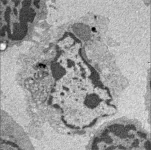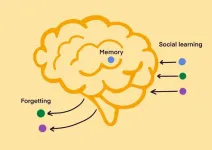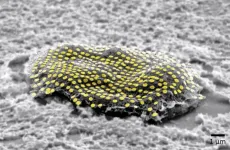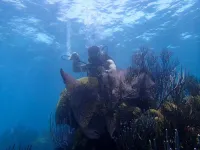(Press-News.org) ITHACA, N.Y. – Geoscientists have long thought that water – along with shallow magma stored in Earth’s crust – drives volcanoes to erupt. Now, thanks to newly developed research tools at Cornell, scientists have learned that gaseous carbon dioxide can trigger explosive eruptions.
A new model suggests that basaltic volcanoes, typically located on the interior of tectonic plates, are fed by a deep magma within the mantle, stored about 20 to 30 kilometers below Earth’s surface.
The research, which offers a clearer picture of our planet’s deep internal dynamics and composition, with implications for improving volcanic-hazards planning, will publish August 7, 2023 at 3:00pm ET in the Proceedings of the National Academy of Sciences.
“We used to think all the action happened in the crust,” said senior author Esteban Gazel, the Charles N. Mellowes Professor in Engineering in the Department of Earth and Atmospheric Sciences, in Cornell Engineering. “Our data implies the magma comes directly from the mantle – passing fast through the crust – driven by the exsolution (the process phase of separating gas from liquid) of carbon dioxide.
“This completely changes the paradigm of how these eruptions happen,” Gazel said. “All volcanic models had been dominated by water as the main eruption driver, but water has little to do with these volcanoes. It’s carbon dioxide that brings this magma from the deep Earth.”
About four years ago, Gazel and Charlotte DeVitre, Ph.D. ’22, now a postdoctoral researcher at University of California, Berkeley, developed a high-precision carbon dioxide densimeter (which measures density in a tiny vessel) for Raman spectroscopy (a device that examines scattered photons through a microscope).
The natural samples – microscopic-sized carbon dioxide rich bubbles trapped in crystals emanating from the volcanic eruption – are then measured via Raman and quantified applying the newly developed densimeter. Essentially, the scientists are examining a microscopic time capsule to provide a history of the magma. This new technique is critical for near real-time precise estimations of magma storage, tested during the 2021 eruption in Las Palmas, in the Canary Islands by Gazel’s group.
Further, the scientists developed methods to assess the effect of laser heating on carbon-dioxide rich inclusions (found swathed in the crystals), and to accurately assess melt inclusion and bubble volumes. They also developed an experimental reheating method to increase accuracy and properly account for carbon dioxide trapped as carbonate crystals inside the bubbles.
“The method of development and instrument design were challenging, especially during the height of the pandemic,” Gazel said.
Using these new tools, the scientists scrutinized volcanic deposits from the Fogo volcano in Cabo Verde, west of Senegal in the Atlantic Ocean. They found a high concentration of volatiles in the micro-sized melt inclusions encased within the magnesium-iron silicate crystals. The higher amount of carbon dioxide enclosed in the crystals suggested that the magma was stored tens of kilometers below the surface – within the Earth’s mantle.
The group also discovered that this process is connected to the deep mantle source that supply these volcanoes.
This implies that eruptions such as Fogo’s volcanic flareups start and are fed from the mantle, effectively bypassing storage in the Earth’s crust and driven by deep carbon dioxide, according to the paper.
“These magmas have extremely low viscosities and come directly from the mantle,” DeVitre said. “So here, viscosity and water cannot play the common roles that they do in shallower and/or more silicic (rich in silica) volcanic systems. Rather at Fogo volcano the magma must be driven up fast by the carbon dioxide and this likely plays a significant role in its explosive behavior. This is a major step in our understanding of the controls on basaltic explosivity.”
Comprehending magma storage helps best prepare society for future eruptions, said Gazel, who is also a faculty fellow at the Cornell Atkinson Center for Sustainability.
“As deep magma storage will not be detected by ground deformation until the melt is close to surface,” he said, “this has important repercussions to our understanding of volcanic hazards. We need to understand the drivers of these eruptions. The only way to see these processes now is by observing earthquakes, but earthquakes don’t tell you exactly what’s happening.”
Said Gazel: “With precise measurements that tell us where eruptions start, where magmas melt and where they are stored – and what triggers the eruption – we can develop a much better plan for future eruptions.”
In addition to Gazel and DeVitre, the other authors of “Oceanic Intraplate Explosive Eruptions Fed Directly from the Mantle” are Ricardo S. Ramalho, Cardiff University, Wales, U.K.; Swetha Venugopal, Lunar and Planetary Institute, Universities Space Research Association, Houston; Matthew Steele-MacInnis, University of Alberta, Edmonton, Alberta; Junlin Hua, University of Texas, Austin; Chelsea M. Allison, Baylor University, Waco, Texas; Lowell R. Moore, Virginia Tech, Blacksburg, Virginia; Juan Carlos Carracedo, Universidad de Las Palmas de Gran Canaria, Spain; and Brian Monteleone, Woods Hole Oceanographic Institution, Massachusetts.
Funding for this research was provided by the National Science Foundation. Data was also collected in the Biotechnology Resource Center at Cornell University; and by the Cornell Institute of Biotechnology's Imaging Facility, which is funded through National Institutes of Health.
-30-
END
Carbon dioxide – not water – triggers explosive basaltic volcanoes
2023-08-07
ELSE PRESS RELEASES FROM THIS DATE:
Inside job: Finding exposes unexpected killer of immune cells lacking self marker
2023-08-07
Researchers at Kobe University discovered an entirely new and unexpected mechanism by which the immune system can get rid of cells lacking molecules that identify them as part of the self in mice. The finding, published in PNAS, has possible implications for cancer treatment.
The immune system comprises many types of cells that work together to fight off diseases. Two important types are dendritic cells and T cells. Dendritic cells are located in strategic positions throughout the body including the gut and skin, as well as in the lymph nodes, sample their environment and present small components derived from these samples on their ...
Memory, forgetting, and social learning
2023-08-07
Social learning is typically thought to be most beneficial when the environments in which individuals live change quite slowly – they can safely learn tried and tested information from one another and it does not go out of date quickly. Innovating brand-new information, on the other hand, is thought to be useful in dynamic and rapidly changing environments.
Researchers Madeleine Ammar, Laurel Fogarty and Anne Kandler at the Max Planck Institute for Evolutionary Anthropology developed an agent-based simulation model of the evolution ...
New method to identify mutations in childhood brain tumors
2023-08-07
Researchers at Uppsala university have developed a new method to find mutations in brain tumors in children. They could also show that the mutations identified by them changes how cancer cells respond to a cancer drug. These findings could lead to better diagnostics and more individualized treatment of children with brain tumors. The study is published in the journal PNAS.
Medulloblastoma is the most common malignant brain tumor in children. It usually develops in the cerebellum and even if modern treatment has improved the prognosis so that over 70% live more than five years, not all patients ...
Climate influences the spread of a life-threatening zoonotic disease in the Amazon
2023-08-07
Outbreaks of polycystic echicnococcosis, a life-threatening zoonotic disease, are driven by regional climate changes, according to a study led by the Barcelona Institute for Global Health (ISGlobal), an institution supported by “la Caixa” Foundation. The findings, published in PNAS, provide evidence of the impact of climate on neglected tropical diseases in the Amazon region, with implications for other zoonoses.
Polycystic echinococcosis (PE) is a neglected life-threatening zoonosis caused by an intestinal worm (Echinococcus vogeli) ...
Research discovers key cause of restricted blood flow to the brain in vascular dementia
2023-08-07
Groundbreaking new research has uncovered a potential route to developing the first ever drug treatments for vascular dementia, that directly target a cause of the condition. The research, funded by the British Heart Foundation and published in the journal Proceedings of the National Academy of Sciences, [1] has shed light on how high blood pressure causes changes to arteries in the brain, a process that leads to the devastating condition.
High blood pressure is a main cause of vascular dementia, a condition characterised by poor blood flow to the brain. The reduced blood supply starves brain cells of nutrients and over time they become damaged ...
Latest in body art? ‘Tattoos’ for individual cells
2023-08-07
Engineers have developed nanoscale tattoos—dots and wires that adhere to live cells—in a breakthrough that puts researchers one step closer to tracking the health of individual cells.
The new technology allows for the first time the placement of optical elements or electronics on live cells with tattoo-like arrays that stick on cells while flexing and conforming to the cells’wet and fluid outer structure.
“If you imagine where this is all going in the future, we would like to have sensors to remotely monitor and ...
Georgia State Researcher awarded $3.6 million grant to help address mental health crisis in schools
2023-08-07
ATLANTA — Catherine Perkins, a clinical professor in the College of Education & Human Development at Georgia State University, has been awarded a five-year, $3.6 million grant by the U.S. Department of Education to expand quality school-based mental health (SBMH) services for underserved populations in high-need schools.
The Expanding Quality SBMH Services for Underserved Populations with Inclusive Practices (GSU-EQUIP) grant will have a direct impact in metro Atlanta by increasing access to school-based programs and strengthening the candidate pool of mental ...
Current estimates of Lake Erie algae toxicity may miss the mark
2023-08-07
COLUMBUS, Ohio – There is more to a harmful algal bloom than the green stuff in water that meets the eye – specifically, a changing hazard level of toxins produced by the microbes that make up the scummy mess.
A new study analyzing toxins produced by Microcystis, the main type of cyanobacteria that compose the annual harmful algal bloom (HAB) in Lake Erie, suggests that the toxicity of the bloom may be overestimated in earlier warm months and underestimated later in the summer.
The research is part of a large project, led by The Ohio State University, designed to develop a more accurate harmful algal bloom toxicity forecast ...
Dogs with less complex facial markings found to be more expressive in their communication with humans
2023-08-07
WASHINGTON (August 7, 2023) – The domestication of canines and their co-evolution with humans has fostered an incredibly unique relationship with these animals. Over time, our four-legged friends have adapted well to understanding human modes of communication, both verbal and nonverbal. However, researchers at the George Washington University say humans could do more to better understand our furry companions, and a dogs’ facial markings may be one key to meeting them halfway.
In a new paper published in the journal Animals, ...
Century-old coral reveals Pacific western boundary current strengthened as climate warmed, impacting El Niño
2023-08-07
Chestnut Hill, Mass. (8/7/2023) - The Pacific Ocean’s western boundary current, which forms a critical regulator of sea surface temperature and weather patterns, has significantly strengthened as the planet warms, according to a new study published in the journal Nature Geoscience.
The study provides the first evidence that the western boundary current in the South Pacific has significantly strengthened during the 20th century in response to global warming, contributing to an intensified equatorial undercurrent, according to Boston College Assistant Professor of Earth and Environmental Sciences Xingchen (Tony) Wang, a co-author ...




